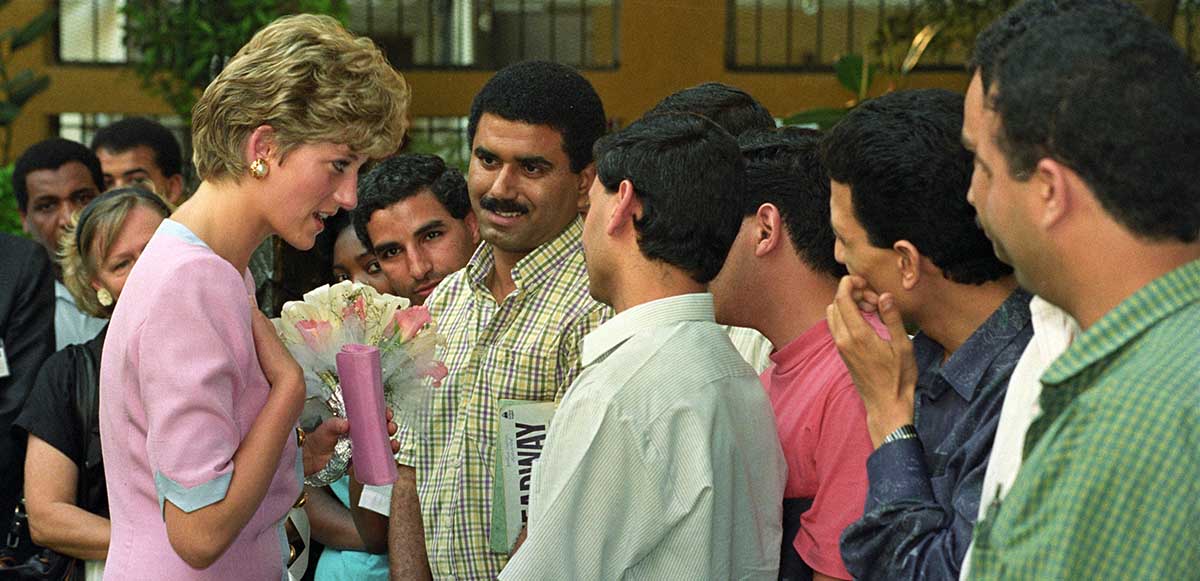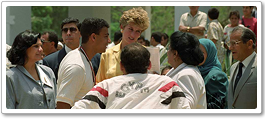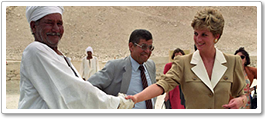Photographs and text by Norbert Schiller

Diana arriving in Egypt.
Lady Di’s 1992 trip to Egypt, like all of her state visits, was extensively covered by the media. However, the British tabloid photographers, whose bread and butter it was to document the princess’s every move, outdid the rest of the pack in their plotting and scheming, hoping to capture exclusive shots which usually caught Diana in some compromising situation. They pushed and shoved each other inside narrow tombs to get the best position, paid a camel driver to discretely place one of his animals in the background as the princess visited the pyramids, but the boldest ploy was the one aimed at snapping pictures of Diana in her bathing suit while she took a break at the pool of the British ambassador’s residence. Amid all this frenzy, Lady Di never lost her cool performing her duties, charming the crowds, and humoring her stalkers.
As usual, Diana looked stunning when she stepped off the plane wearing a brilliant pink and red outfit. As expected, there was an army of photographers, including me, waiting on the tarmac when she disembarked. Camera shutters clicked furiously and flashes exploded in bursts of lights as we documented her every step until she disappeared into the British ambassador’s car and was whisked away.
The next morning Diana visited the British Council, the school for the blind and other charities accompanied by First Lady Suzanne Mubarak. I wasn’t too impressed with the images I took that first day and found them rather ordinary. I was convinced that her first day in Egypt was uneventful until I found out about the pool incident.

Diana meeting with Egyptian President Mubarak and afterwards visiting the Polio Rehabilitation Center.
The following day, the Princess of Whales met with President Hosni Mubarak and then visited the Cairo Institute for Polio Rehabilitation located in Imbaba, an impoverished neighborhood which was also a hotbed for al Gamaa Al Islamiya or Islamic Group, a radical faction which at the time was engaged in a mini war with the government and was waging attacks against foreign tourists, Egyptian politicians, police, and intellectuals. In contrast with the previous day, photo ops in Imbaba were good as Diana mingled and spoke with patients. That afternoon she visited the Pyramids and Sphinx on the Giza plateau.

Diana visiting the Pyramids and Sphinx on the Giza plateau.
The highlight of her visit to the Giza plateau was what she was wearing. The tabloids were upset that she had chosen a tan-colored outfit, which blended with the desert scenery, instead of something more colorful that would make her stand out. The other memorable incident was the affair with the camel. A photographer had paid a camel driver to place one of his animals in the area designated for the photo op, but moments before Diana arrived Egyptian security ordered the camel removed, much to the press’s disappointment.
When I was back at the office filing my pictures, I received a call from the AP London photo desk asking if I had a photo of the princess at the ambassador’s pool from the previous morning. At first I thought one of my colleagues from Reuters or AFP (AP’s two main competitors) had taken that picture and that I was in trouble for missing it. However, when to my great relief I learned that the photo was on the front page of the Mirror, a famous London tabloid, I suddenly remembered the inquiry about the swimming pool.
When there are so many photographers covering a high profile person like Diana, it’s impossible to be everywhere, so the traveling press is divided into smaller groups called “pools.” The next day some photographers accompanied the princess to Al Azhar, the most prominent school of Islamic teaching the world, while the others flew ahead to Aswan in Upper Egypt to wait for her arrival.

Diana visiting the temple of Isis and a school in Aswan.
On the ride to the airport I sat next to the photographer who took that infamous photo of Diana in her swimsuit at the pool. My first question was how he had managed to get up on a rooftop in Cairo’s most heavily guarded neighborhood which, in addition to the British embassy and residence, included the US embassy and at least a half dozen other diplomatic missions, not to mention Egyptian government offices. The photographer had come to Egypt a few days before Diana, scouted out the area near the British residence, and found a bawab or doorman who gave him access to the roof for a price. Although the photographer didn’t disclose how much he paid, the amount he received for the photo was no secret. “How does it feel to make 15,000 British pounds for a single photograph?” I inquired. “Considering that I just spent 30,000 pounds of my own money chasing Fergi (Sarah Ferguson, Duchess of York) throughout Southeast Asia and got nothing for it, it feels pretty good to get some of that money back!” he responded.

Diana walking through Karnak temple.
For her trip to Aswan, Diana picked a pink dress that stuck out beautifully against the desert backdrop and the ancient temple of Isis, allowing for very good pictures. Her next destination was Luxor where she visited sites on both banks of the Nile. Much to the press’s disappointment, she chose to wear another tan outfit. After her stop at Karnak, one of Luxor’s most grandiose temples, we were divided into small pools to cover her visit to the tombs in the Valley of Kings and Queens. The paparazzi were frantic because they saw this as an opportunity to take memorable photos, so squabbling ensued to get the best positions inside the burial chambers. I had previously photographed inside tombs and I was never impressed with the images, so I chose the pool position that no one else signed up for which was the one designated to cover Diana walking among the tombs.
When she emerged from Tutankhamun’s tomb, Diana walked up to one of the caretakers whose father happened to be Howard Carter’s assistant when the British explorer discovered the tomb in 1922. This was a unique opportunity for me, as I was the only photographer to capture this intimate moment in an otherwise overly documented trip. They chatted, and then Diana greeted some British tourists and left.

Diana speaking to tourist in the Valley of the Kings and meeting the son of Howard Carter’s assistant when Carter discovered Tutancamun’s tomb.
That night there was a reception at the British ambassador’s residence in the princess’s honor. I did everything in my power to develop my film, edit, and file the pictures in time to get to the party before the doors were officially shut. After battling Cairo’s insane traffic to get home I grabbed my coat and tie but had no time to clean up as time was running out. When I arrived, I was exhausted and felt out of place among the immaculately looking crowd, so I walked straight to the bar and ordered a scotch on the rocks.
As I was coming back to life, I heard someone behind me say, “Excuse me.” When I turned around I found Diana holding out her hand to greet me. She looked spotless, as if she had not just spend the day in hot and dusty Upper Egypt climbing in and out of tombs. I was stunned by the gesture and not sure how to respond, but after an awkward moment she proceeded to ask me about the son of Carter’s assistant whom she had met that day. She wanted to know why his hand was wrapped in a bandage. After composing myself, I explained that while we were waiting for her, the caretaker noticed a broken bottle on the ground and cut his hand while picking it up. As he had no time to go to the clinic for proper treatment, he just wrapped his hand with a piece of cloth. Diana was noticeably concerned, but I reassured her that it was just a superficial wound. We then exchanged a few niceties before she moved on to mingle with other guests.
Before I revisited Luxor later that year with my family, I made prints of Diana and that caretaker, to give to him. From then onwards, I never had to pay an entrance fee to visit the Valley of the Kings, nor did I have to wait in line to enter any of the tombs.

Diana walking through the graves and laying a wreath at the Commonwealth war cemetery in Heliopolis.
On her last day, Diana visited the WWII Commonwealth Cemetery in Cairo’s northern suburb of Heliopolis. She laid a wreath at the tomb of the Unknown Soldier, presented the Egyptian caretaker with a medal for his many years of service, and walked among the graves of the fallen troops with a member of the British military. With that final visit the Princess of Wales’ Egyptian tour officially ended.
In the early morning of August 31, 1997 I was with my wife and children in Beirut where we were spending the last day of our summer holidays. All of a sudden my mother-in-law barged into the bedroom where we were fast asleep announcing, “Something has happened to Princess Diana.”

The press documenting Diana’s every move.
We all got up and watched as Diana’s car crash played out on TV. My daughter Alexandra, only five at the time, was noticeably upset; in her world princesses were supposed to live forever. We watched the story for as long as we could and then left for the airport to catch a flight back to Egypt. As soon as we arrived at our Cairo flat, we turned on the TV and continued to watch the story unfold.
At the time of her death, it had been just over five years since I had covered Diana’s visit to Egypt. My thoughts immediately drifted back to that photographer’s phone call asking whether the ambassador’s residency had a pool. The idea that her morning swim was that important to the public only highlighted the insanity that fueled the tabloid media to document every step that the princess took. No matter how hard she tried to protect her privacy, she was unable to escape the merciless pursuit which eventually led to her violent and tragic death.



Thanks a lot for documenting this amazing experience. She was a great and wonderful princess loved and appreciated globally. It seems like she had a very keen interest in ancient Egyptian civilization (judging by her awesome tours in Giza and Upper Egypt ). Again, thanks for sharing your documentation.
UK’s Prince Charles visits Egypt, discusses climate change with Sisi – sky nations reporter
[…] 1981, on his honeymoon with his late first wife, Princess Diana. After more than ten years passed, Princess Diana visted Egypt in August […]
The Story Behind Princess Diana’s Awkward Pose at Egypt’s Pyramids | Egyptian Streets
[…] her face, and another one where her foot was tilted up like a ballerina. The British tabloids were disappointed with the photographs, photographer Norbert Schiller noted, not only because the poses were seen as […]
The Story Behind Princess Diana’s Awkward Pose at Egypt’s Pyramids - Israel News Magazine
[…] her face, and another one where her foot was tilted up like a ballerina. The British tabloids were disappointed with the photographs, photographer Norbert Schiller noted, not only because the poses were seen as […]